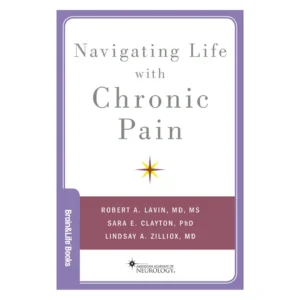
Navigating Life with Chronic Pain
Robert A. Lavin, MD; Sara Clayton, RN; Lindsay Zilliox, PT
Oxford University Press (2020)
- Physical
Key Takeaways
- Pain is more than signals. Thoughts, emotions, and beliefs can turn the pain volume up or down, so mindset matters as much as medicine.
- Control—not cure—is the goal. Small, steady steps toward activity, mood balance, and support networks improve quality of life even when some pain remains.
- Whole-person care works best. Combining movement, medication, therapy, nutrition, and relaxation practices gives the nervous system multiple chances to reset.
- Pacing protects progress. Setting realistic goals and resting before exhaustion prevents flare-ups and builds long-term resilience.
Click to read full summary
The Essentials
Chronic pain affects more than 100 million U.S. adults, yet many feel isolated, misunderstood, or pressured to “push through.” Navigating Life with Chronic Pain starts by reminding readers they are not alone and explains—in clear language—how pain becomes chronic when nerve signals, brain interpretation, and emotional context create a self-reinforcing loop.
The authors outline practical tools that break this loop: gentle exercise, cognitive-behavioral skills, mindfulness, balanced nutrition, and supportive relationships. Real-life stories and worksheets turn concepts into day-to-day actions, helping readers build confidence and regain meaningful activities without overdoing it.
Why This Matters for FND
People with Functional Neurological Disorder often experience pain, fatigue, or weakness that scans can’t fully explain—leading to gaslighting or self-doubt. This book embraces the biopsychosocial model, validating that pain is real even when tests look normal. Its step-by-step strategies dovetail with common FND treatments such as pacing, graded exercise therapy, mindfulness, and CBT, making it a valuable companion on the FND journey.
Resource Qualities
Applicability
Accessibility
Evidence-Based
Practical Value
Practical Applications
For Individuals with FND
- Low-Energy Days: Practice five minutes of diaphragmatic breathing while seated or lying down to calm the pain-anxiety loop.
- Building Long-Term Wellness: Use the book’s pacing worksheet to set a “just-right” daily step count, increasing by 5–10 % each week.
For Care Partners
- Supporting Your Loved One: Offer to track activity goals together, celebrating small wins rather than pain-free days.
For Your Well-being: Apply the same pacing principle to your caregiving—schedule brief breaks to stretch, breathe, or phone a friend before fatigue sets in.
When This is Most Helpful
- Newly diagnosed individuals seeking validation and first-step strategies.
- During symptom management phases when pain flares threaten progress.
- Care partners learning to provide balanced support without burnout.
This resource summary is provided for informational purposes only and does not constitute medical, financial, or legal advice. The content is not intended to replace professional consultation or treatment. Always consult with qualified providers regarding your specific circumstances, symptoms, or questions.
